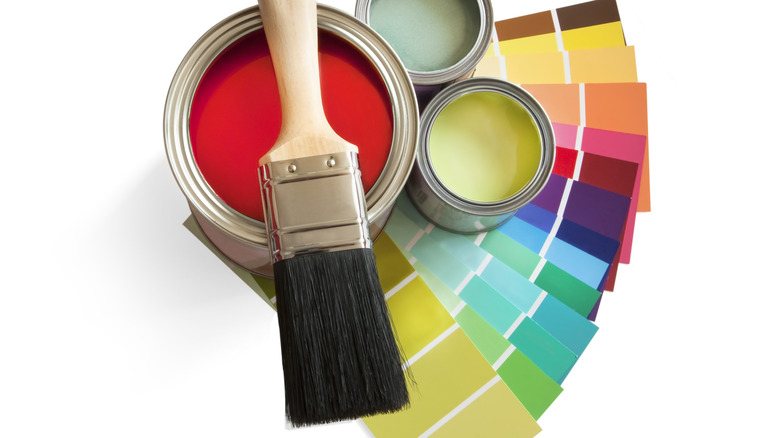The Best Way To Paint The Perfect Ombré Accent Wall
Ombré itself is art and to paint a wall using this technique is to partake in a challenging but worthwhile project. A perfectly executed ombré shading effect will be subtle in its transition from light to dark or vice versa, usually of the same color. Blending will be smooth and appear effortless, giving the eyes a delicious design element upon which to feast. Not all walls that transition between colors are ombré; Architecture Art Designs explains that a similar gradient technique called degradé employs a more abrupt crossover between different colors. The biggest distinction between the techniques is not so much the use of color as the merging of them.
So, the first step in this project is deciding whether you want a smooth ombré effect or the bolder look of degradé, because it may impact your color choices. Whichever method you choose, it'll help to practice on a board before attempting the technique on your wall. If you're nervous about making a mistake, remember it's just paint and mistakes are generally fixable or can be painted over. And, in the end, if you don't like how it turns out, you could always consider applying an ombré wallpaper.
Setting up for your paint adventure
Make sure you're choosing the right room for an accent wall. According to 360 Painting, creating a focus wall is a good idea for rooms that have abundant natural lighting that are also spacious or have open floor plans. A room with a nook or other interesting feature can also be an excellent place for an artful paint application. It's important to note that a small room may feel even more cramped with an accent wall.
Painting a gradient design to create your statement is similar to any other paint project as far as necessary supplies. You'll want to prep your wall by making sure it's clean and free of nails or other fasteners. Also make sure any holes have been filled. The wall should be primed first, but you can opt for paint that has primer pre-mixed into it to save some time. Most ombré walls use three colors or shades for ideal transitioning, but the effect can be beautifully achieved with as few as two or as many as five.
Other items you'll need include paint rollers and skins, a paint tray for each color, a drop cloth or two, and some painter's tape to protect molding and anything you don't want paint to get on. Sherwin Williams also recommends one 4-inch brush per color for blending.
Creating the effect on your accent wall
Using the cloth and painter's tape, protect areas that could unintentionally come into contact with paint. Then, coat the wall with primer and allow it to dry (skip this step if your paint has primer in it). Follow up by rolling and cutting in the edges of the entire wall with the lightest shade of paint. It's important to allow this to dry before proceeding with subsequent colors.
Next, Sherwin Williams recommends measuring and marking your wall into sections to create a guide for applying the additional colors, but it's also perfectly acceptable to freestyle it in your own artistic way, including the amount of blending. Decide if the darkest color will go at the top or bottom and then begin painting sections one at a time. The shades should go in order from dark to light, leaving a little space between sections. There's no need for perfection because you'll be adding more paint and blending later.
To begin the blending process, work in small sections and paint a thick line of each color where they meet. Sherwin Williams says to use a paint brush to blend the colors together in an X pattern. Keep working at it until the gradient becomes smooth. For a dramatic effect, allow a bolder separation of color or let brush strokes show. Like a work of art, an accent wall is meant to be a focus piece and the design is all up to you.


